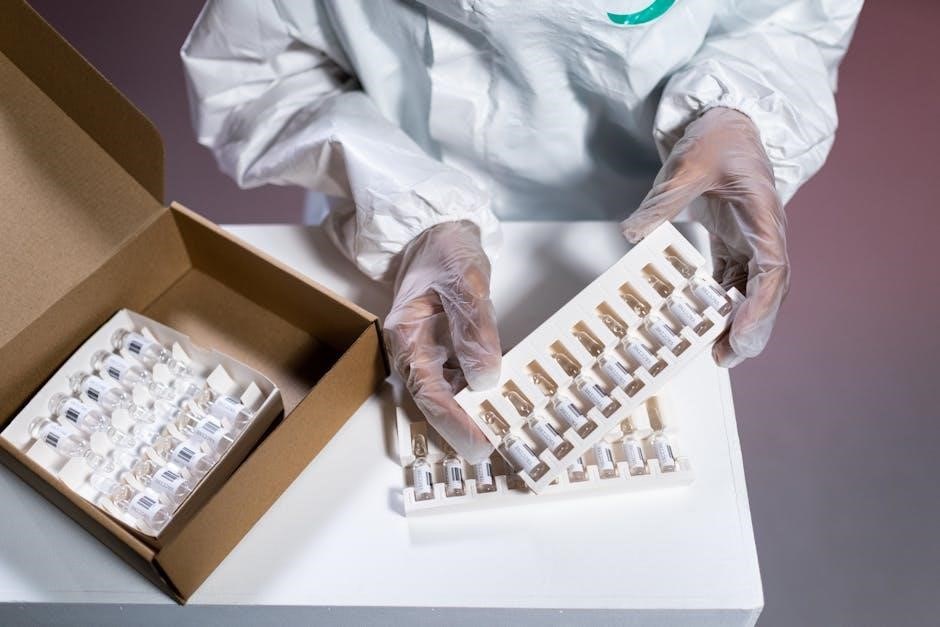The Clinical Global Impression Scale (CGI) is a widely used tool in clinical practice and research to assess the severity of illness and improvement in patients.
1.1 Definition and Purpose
The Clinical Global Impression Scale (CGI) is a clinician-administered tool used to assess the severity of a patient’s mental illness and their improvement over time. It employs a 7-point scale, ranging from “normal, not at all ill” to “among the most severely ill.” The primary purpose of the CGI is to provide a global evaluation of a patient’s condition, considering both symptom severity and functional impact. It is widely used in clinical trials and practice to monitor treatment response and disease progression, offering a straightforward yet effective measure of clinical outcomes.
1.2 Historical Development
The Clinical Global Impression Scale (CGI) was introduced in the 1970s as part of the Early Clinical Drug Evaluation Unit (ECDEU) assessment manual. Initially developed for psychopharmacology research, it aimed to provide a standardized method for clinicians to assess treatment response. Over time, the CGI has evolved to include two main components: the Severity of Illness Scale (CGI-S) and the Global Improvement Scale (CGI-I). Its simplicity and clinical relevance have made it a cornerstone in both clinical trials and routine patient care, with widespread adoption across various mental health disciplines. This evolution underscores its enduring utility in modern psychiatry.

Structure of the CGI Scale
The CGI Scale includes the Severity of Illness (CGI-S) and Global Improvement (CGI-I) scales, both using a 7-point rating system to assess patient condition and change.
2.1 Severity of Illness Scale (CGI-S)
The Severity of Illness Scale (CGI-S) assesses the clinician’s impression of a patient’s current illness severity. Rated on a 7-point scale, it ranges from 1 (normal, not ill) to 7 (extremely ill). This scale provides a global evaluation of the patient’s condition, considering all available clinical information. Widely used in psychiatry and neurology, the CGI-S is a simple yet effective tool for monitoring disease progression and treatment response. Its subjective nature allows clinicians to tailor assessments to individual patients, making it a valuable instrument in both clinical practice and research settings.
2.2 Global Improvement Scale (CGI-I)
The Global Improvement Scale (CGI-I) measures the clinician’s assessment of a patient’s improvement since the start of treatment. Rated on a 7-point scale, it ranges from 1 (very much improved) to 7 (very much worse). This scale provides a clear indication of treatment efficacy and patient progress over time. Often used in conjunction with the CGI-S, the CGI-I offers a dynamic perspective on clinical outcomes. Its simplicity and clinical relevance make it a valuable tool for tracking changes in patient condition during therapeutic interventions.
2.3 Scoring System: 7-Point Scale
The CGI utilizes a 7-point scale to rate both severity and improvement. Scores range from 1 (normal, no illness) to 7 (extremely ill or worsening). For CGI-S, 1 indicates no illness, while 7 represents extreme severity. The CGI-I scores reflect improvement, with 1 being “very much improved” and 7 “very much worse.” This structured scoring system ensures consistency and clarity, allowing clinicians to accurately assess and communicate patient progress. Its simplicity enhances reliability across diverse clinical settings and patient populations, making it a robust tool for both research and practice.

Administration and Interpretation
The CGI assessment is based on clinical expertise, comparing a patient’s baseline condition to their current state. Widely used in trials and practice, it aids in monitoring progress effectively.
3.1 How to Administer the CGI Scale
The CGI scale is administered by trained clinicians who assess patients based on their clinical experience. The process involves evaluating the patient’s condition at baseline and monitoring changes over time. Clinicians rate the severity of illness using the CGI-S and improvement using the CGI-I, both on a 7-point scale. The assessment requires a comprehensive understanding of the patient’s symptoms and functional impairment. The scale is typically completed during clinical visits, ensuring consistency and accuracy in tracking patient progress. Proper training is essential to maintain reliability and validity in CGI administration across different clinical settings.
3.2 Clinician’s Role in Assessment
Clinicians play a pivotal role in administering the CGI scale, as their expertise ensures accurate and reliable assessments. They evaluate patients’ symptoms, functional impairment, and overall clinical presentation. The clinician’s judgment is critical in assigning scores on the 7-point scale, reflecting their professional experience. They must remain impartial and base ratings on observable changes and patient history. Regular training and familiarity with the scale are essential to maintain consistency. The clinician’s role extends to interpreting scores, providing context, and integrating CGI data into broader treatment plans, making it invaluable in both clinical practice and research settings.

Applications in Clinical Practice
The CGI scale is extensively used in psychiatry, neurology, and clinical trials to assess treatment response and monitor patient progress, providing valuable insights for clinical decision-making.
4.1 Use in Psychiatry and Neurology
The CGI scale is extensively applied in psychiatry and neurology to evaluate the severity of mental health disorders, such as schizophrenia, depression, and anxiety. Its simplicity and clinical relevance make it a valuable tool for assessing treatment response and disease progression. In neurology, it is used to monitor conditions like epilepsy and Parkinson’s disease. Clinicians rely on CGI to gauge improvement or deterioration, ensuring personalized care. This scale is particularly useful in clinical trials for neuropsychiatric disorders, offering a standardized method to track patient outcomes and therapeutic efficacy.
4.2 Application in Clinical Trials
The CGI scale is a cornerstone in clinical trials, providing a standardized measure of symptom severity and treatment response. Its 7-point rating system allows for consistent assessment across studies, enhancing reliability. In trials for neuropsychiatric conditions, CGI is often used alongside disease-specific scales to capture both general and detailed outcomes. This dual approach ensures comprehensive evaluation of therapeutic effects. The scale’s simplicity facilitates quick data collection, making it ideal for large-scale trials; Its widespread adoption has contributed to the validation of numerous treatments, solidifying its role as a key endpoint in clinical research.

Advantages and Limitations
The CGI scale is simple, clinically relevant, and widely used, but its subjectivity and limited sensitivity to change are notable drawbacks in clinical assessments.
5.1 Strengths: Simplicity and Clinical Relevance
The CGI scale is renowned for its simplicity, requiring minimal training to administer and interpret. Its clinical relevance lies in providing a global assessment of symptom severity and improvement, making it highly applicable in diverse clinical settings. The 7-point scale offers clarity and ease of use, allowing clinicians to quickly gauge patient progress. Its adaptability across various mental health conditions enhances its utility in both routine practice and clinical trials. This straightforward yet effective tool bridges research and clinical care, ensuring consistent and reliable outcomes.
5.2 Weaknesses: Subjectivity and Lack of Sensitivity
Despite its advantages, the CGI scale has notable limitations. Its reliance on clinician judgment introduces subjectivity, potentially leading to variability in ratings. The 7-point scale lacks sensitivity, as subtle changes in symptoms may not be accurately captured. This can affect its ability to detect nuanced improvements, especially in clinical trials requiring precise measurements. Additionally, the scale’s broad nature may not address specific symptoms or conditions, limiting its diagnostic utility. These weaknesses highlight the need for complementary assessments to enhance accuracy and comprehensiveness in patient evaluations.

Relevance in Modern Research
The CGI remains a standard tool in modern research, offering a clear, consistent measure of symptom severity and treatment effects across various psychiatric and neurological studies.
6.1 Recent Studies Utilizing the CGI Scale
Recent studies have increasingly utilized the CGI scale to assess treatment response and illness severity across various conditions. In 2024, research by AS Romanov applied the CGI to evaluate epilepsy patients, demonstrating its effectiveness in clinical settings. Similarly, studies in psychiatry, such as those by TS Syunyakov in 2016, employed the CGI to measure symptom improvement in depressive and manic episodes. The scale’s simplicity and clinical relevance make it a preferred tool in both clinical trials and real-world applications, as highlighted in recent works by AE Protasova and SA Galkin. Its adaptability ensures continued relevance in modern research.
6.2 Comparisons with Other Rating Scales
The CGI scale is often compared to other rating tools, such as the Brief Psychiatric Rating Scale (BPRS) and the Sheehan Scale, in clinical research. While the BPRS provides detailed symptom assessment, the CGI offers a broader, more global perspective. Studies, such as those by SA Galkin in 2021, highlight that the CGI and BPRS differ in sensitivity, with the CGI being less granular but more clinically intuitive. Similarly, the Sheehan Scale focuses on functional impairment, whereas the CGI emphasizes overall illness severity. Such comparisons underscore the CGI’s unique value in assessing patient improvement and severity in a concise manner.

Practical Examples and Case Studies
Case studies demonstrate CGI’s practical use in assessing epilepsy patients and schizophrenia treatment response. For example, AS Romanov’s study used CGI to evaluate seizure severity effectively.
7.1 CGI in Assessing Treatment Response
The CGI scale is a valuable tool for evaluating treatment response in clinical settings. It assesses changes in symptom severity and overall improvement, providing clear insights into patient progress. Clinicians use the CGI-S to measure baseline severity and the CGI-I to track improvements over time. This dual assessment enables a comprehensive understanding of treatment efficacy. In clinical trials, CGI scores are often analyzed alongside other scales, such as the Sheehan Scale, to validate results. The simplicity and clinical relevance of CGI make it an essential instrument for guiding treatment decisions and monitoring patient outcomes effectively.
7.2 Real-World Applications in Patient Care
In real-world patient care, the CGI scale serves as a practical tool for clinicians to monitor disease progression and treatment response. Ward epileptologists, for instance, use CGI-S to assess seizure severity. Psychiatrists and neurologists employ CGI-I to evaluate symptom improvement. The scale’s simplicity allows for quick assessments, aiding in timely clinical decisions. In diverse settings, CGI supports personalized care, ensuring treatments align with patient needs. Its universal application across mental health and neurological disorders underscores its versatility and value in daily clinical practice, enhancing patient outcomes through informed, tailored interventions.
The CGI scale remains a vital tool in assessing mental health conditions, offering simplicity and clinical relevance. Future enhancements may focus on improving sensitivity and objectivity.
8.1 Impact of CGI on Clinical Practice
The Clinical Global Impression Scale has significantly influenced clinical practice by providing a straightforward yet effective tool for assessing patient outcomes. Its simplicity and clinical relevance make it a valuable instrument for clinicians to gauge illness severity and treatment response. Widely adopted in psychiatry and neurology, CGI facilitates consistent communication among healthcare providers, enhancing decision-making. It also serves as a practical measure for monitoring progress in routine patient care, making it indispensable in both clinical trials and everyday practice. CGI’s impact lies in its ability to bridge research and real-world applications effectively.
8.2 Potential for Future Enhancements
Future enhancements of the CGI scale could include integrating digital tools to improve objectivity and consistency. Expanding its application to diverse patient populations and conditions may enhance its utility. Incorporating patient-reported outcomes alongside clinician assessments could provide a more holistic view. Additionally, developing culturally adapted versions to ensure cross-cultural validity is crucial. Enhancing the scale’s sensitivity to detect subtle changes in symptom severity could improve its effectiveness in longitudinal studies. These advancements would maintain CGI’s simplicity while addressing its limitations, ensuring its continued relevance in clinical practice and research.
